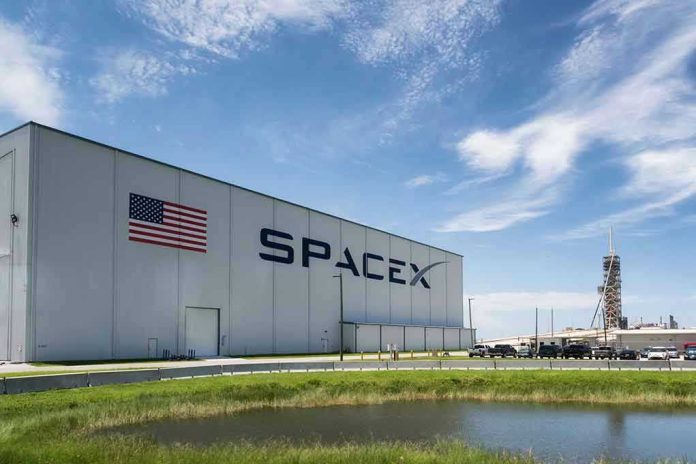
SpaceX’s plan to nearly double rocket launches from Vandenberg faces fierce opposition from California regulators, revealing a new front in the battle over federal authority, economic growth, and state-driven environmental restrictions.
Story Highlights
- SpaceX seeks approval to boost annual launches from Vandenberg from 51 to 95, making it possibly the world’s busiest spaceport.
- California’s Coastal Commission is pushing back, citing concerns over noise, wildlife, and the adequacy of state oversight.
- The dispute spotlights tension between federal control, private innovation, and state-level environmental intervention.
- The unresolved regulatory fight may set lasting precedents for commercial space and state authority over federally managed sites.
SpaceX Expansion Sparks Regulatory Showdown
SpaceX’s proposal to increase launches at Vandenberg Space Force Base would transform the site into one of the most active spaceports worldwide. The company, which already led 46 out of 51 launches from the base in 2023, seeks operational flexibility to meet growing demand for Starlink deployments and other missions. California’s Coastal Commission, however, has raised objections, citing risks to coastal wildlife, noise pollution, and the adequacy of state involvement in overseeing federally controlled activities. This confrontation has drawn attention to the limits of state authority over federal facilities, especially when economic growth and national security interests are at stake.
Regulatory tensions have escalated in recent months as SpaceX’s launch cadence continues to rise. In August 2025, the company accounted for 33 of 38 launches at Vandenberg, with plans for up to 76 at-sea landings off Baja California using Port of Long Beach infrastructure. The Coastal Commission’s staff reports highlight a lack of communication and stalled progress on key mitigation goals. Despite the unresolved disputes, SpaceX and the U.S. Space Force show no signs of slowing their ambitious schedules, underscoring federal priorities over state-level objections. The next launches are already scheduled for mid-August, reflecting the ongoing pace of activity.
Economic Growth Versus Environmental Oversight
SpaceX’s expansion promises a significant economic boost for California’s central coast, with increased launches bringing jobs, logistical contracts, and local investment. The Port of Long Beach stands to benefit from heightened activity related to booster recovery and transport. Yet, these economic incentives are weighed against mounting community concerns over quality of life, noise, and environmental justice. Local residents and environmental groups have reported past disturbances from sonic booms and habitat disruption, issues that have previously led the Coastal Commission to attempt imposing conditions—though enforcement remains limited due to federal jurisdiction. The unresolved regulatory conflict may ultimately determine how much say states will have in future commercial space operations.
Short-term implications include more frequent noise events and potential wildlife disruption, while long-term consequences could involve expanded state regulatory power over federal projects. The debate also raises important questions about balancing American innovation and technology leadership with environmental stewardship and local quality of life. For conservative audiences, the case highlights the dangers of unchecked state intervention potentially stifling economic growth and national security progress. The outcome may influence how other states approach commercial space expansion and how companies like SpaceX select and develop launch sites.
Stakeholders, Power Plays, and the Path Forward
The key players in this regulatory battle include SpaceX, the California Coastal Commission, the U.S. Space Force, and local communities. SpaceX drives innovation and job growth while seeking minimal regulatory obstruction. The Coastal Commission, empowered by its environmental mandate, aims to exert state control even on federal land. The Space Force, responsible for base operations, prioritizes national security and commercial readiness. Each group brings distinct motivations, but the clash is ultimately about power: federal supremacy versus state oversight, economic opportunity versus environmental precaution. The dispute’s resolution could set national precedents for how much authority states can wield over federally managed sites—especially when critical technological infrastructure is on the line.
I am glad both @SpaceX and the @SpaceForceDoD are pushing back against the biased coastal commission.
SpaceX, California Clash Over Proposed Rocket Launch Expansion https://t.co/CyVsfwpmzE
— Accipiter striatus (@PeterGordon_CBP) August 9, 2025
Expert analysis underscores the complexity of this situation. Legal scholars note the unresolved tension between federal supremacy and state environmental law, while aerospace professionals stress the need to balance innovation with local impact. Industry analysts agree that the case’s outcome could reshape the regulatory landscape for commercial space nationwide, influencing policy, investment, and technological advancement. For readers concerned with government overreach and the erosion of economic freedom, this regulatory showdown at Vandenberg stands as a crucial test of federalism, local power, and the future of American space leadership.
Sources:
SpaceX planning Saturday evening launch from Vandenberg Space Force Base
Live coverage: SpaceX to launch 24 Starlink satellites on Falcon 9 rocket from Vandenberg
Vandenberg SFB Launch Schedule
NextSpaceflight – Upcoming Launches







